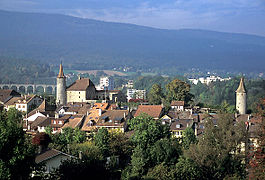Boudry
| Boudry | ||
|---|---|---|
 |
||
|
||
| Coordinates: 46°57′N 6°50′E / 46.950°N 6.833°ECoordinates: 46°57′N 6°50′E / 46.950°N 6.833°E | ||
| Country | Switzerland | |
| Canton | Neuchâtel | |
| District | Boudry | |
| Area | ||
| • Total | 16.77 km2 (6.47 sq mi) | |
| Elevation | 460 m (1,510 ft) | |
| Population (Dec 2015) | ||
| • Total | 5,720 | |
| • Density | 340/km2 (880/sq mi) | |
| Postal code | 2017 | |
| SFOS number | 6404 | |
| Surrounded by | Bevaix, Bôle, Brot-Dessous, Chevroux (VD), Colombier, Cortaillod, Delley-Portalban (FR), Gletterens (FR), Gorgier, Neuchâtel, Noiraigue, Rochefort | |
| Twin towns | Voujeaucourt (France) | |
| Website |
www SFSO statistics |
|
Boudry is the capital of the district of Boudry in the canton of Neuchâtel in Switzerland.
Boudry is first mentioned in 1278 as Baudri.
There are numerous prehistoric settlements around Boudry. These include the neolithic stilt houses on the banks of Lake Neuchâtel, the caves of Abri Baume du Four (occupied from the Neolithic to the La Tène period), tumuli of the Hallstatt period in the Vallon de Vers and two Celtic villages at Les Buchilles. There a number of Roman era artifacts and a Burgundian cemetery at Bel-Air by the Areuse river.
During the Middle Ages it was the capital of the seigneurie of Boudry. Until the 14th Century, the hamlets of Pontareuse and Vermondins were part of the seigneurie. Pontareuse was near the bridge, with which the Roman road of Vy d'Etraz crossed the Areuse, while Vermondins was on a plateau near the modern city of Boudry. In 1282, Pierre de Vaumarcus sold the jurisdiction rights to Girard d'Estavayer. In 1313, his son Rollin sold these rights to count Rudolph IV of Neuchâtel. Two years before, Rudolph IV had seized the Bailiwick of Areuse from Pierre d'Estavayer. Boudry Castle was probably built before 1278 by the Counts of Neuchâtel. So the purchase in 1313 united both of these lands together with the castle lands under the Counts of Neuchâtel.
The castle was often given as a feudal landholding to daughters or wives of the House of Neuchâtel. On 12 September 1343, Count Louis granted the town a charter modeled after the laws of the city of Neuchatel, albeit with some limitations. In 1369 they acquired the right to collect the Ungeld or excise tax in the towns of Boudry and Cortaillod. In 1373, Marguerite de Vufflens, the widow of Louis of Neuchâtel, was given the office of Castellan in Boudry. However, the stormy relationship between the citizens and the family caused Isabella of Neuchâtel to give the office to her mother-in-law in 1379. The castellan office in Boudry was temporarily held by Girard of Neuchatel, the Lord of Vaumarcus, between 1394 and 1413. Then it went to the Counts of Neuchatel. The castellan had jurisdiction over both Boudry, the nearby priory of Bevaix and part of Bôle. The court had 14 judges and was chaired by the governor or his castellan. Before 1832, the civil courts of Rochefort, Bevaix and Cortaillod were all under Boudry. The civil courts were dissolved in 1832 and the three towns were all brought directly under the court of Boudry.
...
Wikipedia



